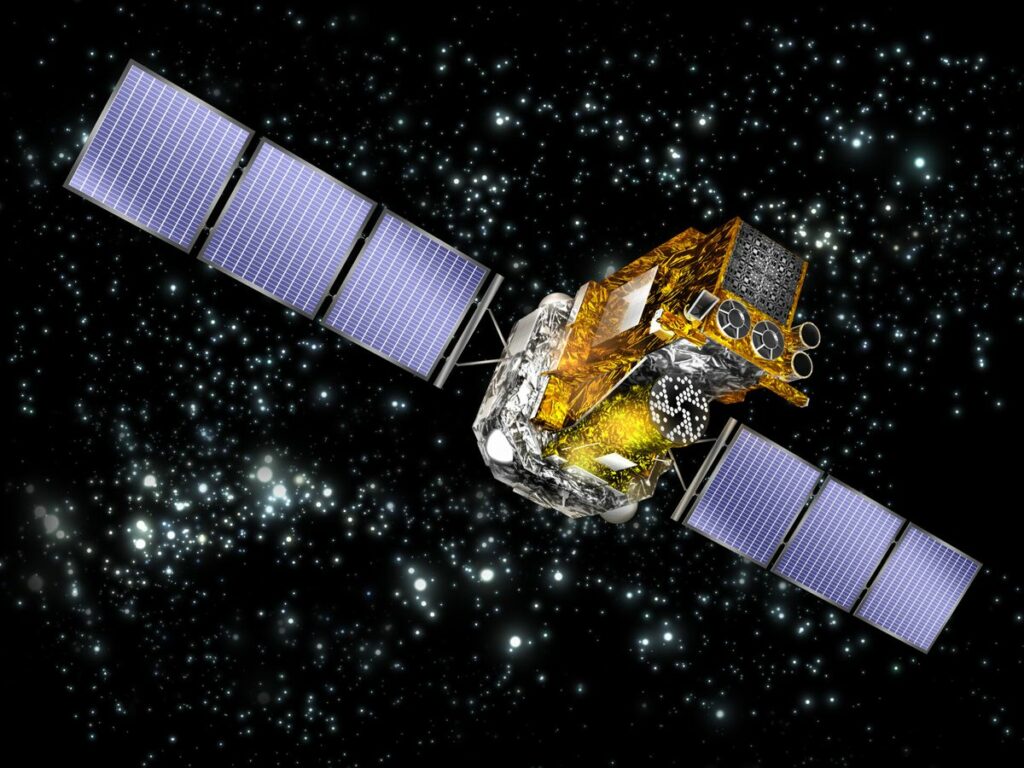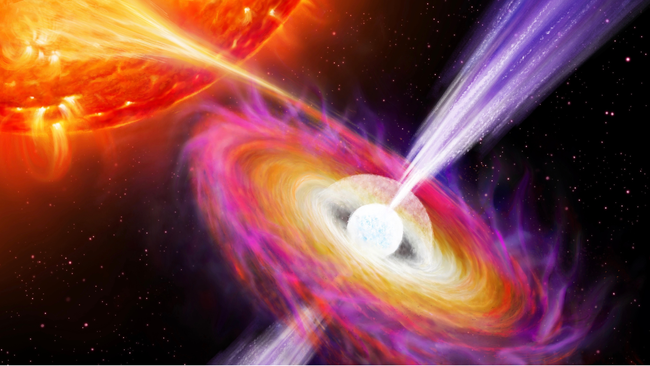Neutron stars emitting powerful bursts known as ‘vampire’ blasts are associated with jets moving at velocities close to the speed of light.
This will assist us in comprehending the process by which jets are propelled from various entities, including the supermassive black holes located at the cores of galaxies.
A neutron star is the remnant of a massive star that perished in a supernova explosion. Neutron stars are widely regarded as some of the most extreme objects in the observable universe, particularly when they coexist with companion stars (which are still alive) in close proximity, allowing the neutron star’s intense gravity to pull material from the companion star. Essentially, the companion star becomes the neutron star’s stellar victim.
These “vampire neutron stars” are unique in that they revive themselves akin to a cosmic Bela Lugosi. This revival is triggered by material falling from the companion star, leading to thermonuclear explosions on the neutron star’s surface. Some of the stolen material is directed towards the poles of the neutron star, where it erupts at speeds close to that of light in the form of powerful astrophysical jets. However, the exact mechanism behind the launch of these jets and their connection to the thermonuclear bursts has remained a mystery.
Recent research has provided a clue to this puzzle. Scientists have identified a method to measure the speeds of these jets and correlate them with the characteristics of both the neutron star and its binary companion star. This breakthrough could potentially help unravel the mystery surrounding these jets and provide insights into other celestial objects that strip material from companion stars, such as supermassive black holes.
Lead author and scientist at the National Institute for Astrophysics (INAF), Thomas Russell, stated, “For the first time, we have successfully measured the speeds of the steady jets emanating from a neutron star. These jets, similar to those from accreting black holes, play a crucial role in our universe by releasing vast amounts of energy into their surroundings, influencing star formation, galaxy evolution, and even the clustering of galaxies. However, the mechanism behind the launch of these jets remains poorly understood.”
Russell provided an explanation that, in the past, scientists believed the jets could be initiated either by the rotation of material stripped from a star that is being pulled inwards. Another theory suggested that the jets are linked to the spin of the rotating object itself.
This recent research has the potential to determine which mechanism is primarily responsible.
Russell further stated, “Our discovery of a correlation between the thermonuclear explosions and the jets now provides us with a readily accessible and repeatable method to unravel the launching mechanism of the jets in neutron stars. Since we believe that jets are launched in similar ways for all types of objects, this will aid in comprehending how jets are launched from various objects, including the supermassive black holes located at the centers of galaxies.”
How do neutron stars blow their top?
Russell and his team conducted a study on two systems containing feeding neutron stars, namely the X-ray binaries 4U 1728-34 and 4U 1636-536, in order to draw their conclusions. These systems are known to have periodic thermonuclear bursts.
Thermonuclear explosions occurring on the surfaces of neutron stars have been a subject of interest for scientists for a long time. Russell mentioned that astronomers have observed a total of at least 125 neutron stars that exhibit bursting phenomena.
“When matter from a nearby star is accreted onto the neutron star, it accumulates on its surface,” Russell explained. “Eventually, the pressure reaches a critical point, leading to an unstable thermonuclear explosion that rapidly spreads across the entire surface of the neutron star.”
The bursts associated with 4U 1728-34 and 4U 1636-536 are detectable in the X-ray spectrum, allowing the team to utilize the European Space Agency’s INTEGRAL space telescope to observe them.
“Our research revealed that these explosions result in additional material being injected into the jets during the burst duration,” Russell added. “By using radio telescopes like the Australia Telescope Compact Array to monitor the jets, we were able to track the flow of this extra material, essentially giving us a cosmic speed camera to measure the speed of the jets.”

The researchers were surprised by the distinct response observed in the jets, as they witnessed very bright and clear flares cascading down the jet, which were easily identifiable. They had anticipated some sort of reaction, but had expected it to be much more subtle.
Neutron star jets caught speeding
The team emphasizes that the speeds of these jets were the missing element in solving the puzzle. This discovery has provided a valuable opportunity to understand how the jets are launched. Russell states that the speed plays a crucial role in unraveling this mystery and this breakthrough allows them to explore this question further. They can now apply this experiment to various other neutron stars that experience explosive feeding events, enabling them to compare the correlation between jet speed and other factors such as spin, mass, and magnetic field. These factors are believed to be essential in the process of jet launching.
If the team identifies a correlation between one of these properties and the jet speed, it will unveil the primary mechanism responsible for launching these jets. It could be either the spin of the neutron star or the rotation of the infalling material.
While this is the first time the speed of a jet from a neutron star has been measured, it is worth noting that it has been previously measured for black holes. However, Russell explains that neutron stars have a significant advantage over black holes when it comes to investigating jet-launching mechanisms.
He highlights that neutron stars have accurately measured spins, well-determined masses, and possibly even known magnetic field strengths, which are much more challenging to measure in black holes. Therefore, it is only through studying neutron stars that they can currently begin to establish connections between system properties and the formation of jets.
The team has observed this outcome in two feeding neutron star systems thus far. However, they are currently examining other bursting neutron stars to determine the variations in jet speeds based on different neutron star characteristics. Once an adequate sample size is obtained, they will be able to identify the essential properties for jet production and understand the mechanisms behind jet launch.
The team’s research was published on Wednesday (March 27) in the journal Nature.
Do not forget to share your opinion with us to provide you with the best posts !




0 Comments